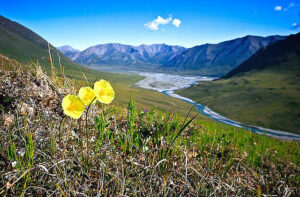
Breaking news: Congress uses budget to drill Arctic Refuge
What is special interests’ latest attempt to push oil and gas drilling in the Alaska National Wildlife Refuge? Using the budget reconciliation process.
Congress is trying to use the budget process to open the iconic and pristine Arctic Refuge to oil and gas development—and they are trying to do it without transparency and debate.
Changing current law to benefit a few
First, the basics: The budget resolution is an annual blueprint for all federal revenues and spending. Congress is not required to use the budget reconciliation process, however. It’s optional.
But the reconciliation process lets Congress change substantive laws as a way to meet specific budget targets. In other words, budget reconciliation could be used as a back-door way to open an area like the Arctic Refuge to oil and gas development.
In the budget reconciliation process, Congress first adopts a budget resolution that includes instructions for one or more committees to meet certain spending or revenue goals. The second step is for those committees to create legislation to meet those budget goals.
Using the reconciliation process means Congress is trying to promote oil and gas development in the Arctic Refuge without scientific and public scrutiny.

The Porcupine Caribou Herd on the coastal plain is threatened as Congress uses budget to drill Arctic Refuge. USFWS photo.
A drilling agenda
The 2018 U.S. House of Representatives’ resolution includes specific revenue goals that include drilling in the Arctic Refuge. To meet these goals, the House Natural Resources Committee will likely draft legislation that raises revenues in an amount the government might potentially get if it opens the Arctic Refuge to oil and gas drilling.
Let’s break this down again. In order to promote drilling in the Arctic Refuge—an agenda that well-funded oil and gas lobbyists have pushed for decades—the House Budget Committee set revenue goals that include drilling the Arctic Refuge.
A stranglehold on debate
If the House Natural Resources Committee drafts legislation to open the Arctic Refuge, that language will be included in the overall reconciliation bill. That bill will then be voted on by the full U.S. House of Representatives.
The Senate will also be going through a similar process. One thing that makes budget reconciliation so dangerous in the Senate is that, unlike the usual legislative process where there is no cap on the time for debate, , budget reconciliation only gives Senators 20 hours to discuss a bill. Such a bill could include dozens of changes to laws impacting the health, wellbeing, and interests of Americans across the country.

The Arctic Refuge provides vital migration and calving habitat for the Porcupine Caribou Herd. USFWS photo.
Worst yet, even if the science, evidence, and public input show severe negative impacts to American interests, Senators cannot stop the bill with a filibuster.
If some members of Congress get their way, the budget reconciliation process will open up the largest, wildest, and most iconic refuge in the country to drilling.
Evading scrutiny is not a new tactic
The effort to push drilling in the Arctic Refuge by using the budget reconciliation process is not new. In 2005, then-U.S. Representative Markey (now Senator Markey (D-MA)), offered this view of the process:
“So the choice comes down to this—do we raise $2.4 billion by prying open and forever destroying a national wildlife refuge, overturning forty years of established environmental policy, threatening the way of life of the Gwich’in peoples, and allowing the oil and gas industry to select any of our other 544 national wildlife refuges as their next target, or do we give the Secretary the discretion to raise by a tiny fraction the royalty rate paid by the wealthiest corporations in the world for producing oil on the public’s land? This is simply a question of whether we would rather protect public land or big oil companies.”
Thankfully, reason prevailed and the Arctic Refuge provisions were removed from the reconciliation bill in 2005.
Keeping the largest and wildest refuge pristine
The 19.2 million-acre Arctic Refuge is America’s largest refuge. It is pristine, wild land. It provides habitat for fish, migratory birds, and mammals like caribou, bears, and wolves. The 1.5 million-acre coastal plain is the biological heart of the Arctic Refuge. Its subsistence resources have sustained Alaska Native people for thousands of years.
The Gwich’in people consider the Porcupine Caribou Herd the foundation for their social, cultural, and spiritual lives, and that herd relies on the Arctic Refuge’s coastal plain.
The Arctic Refuge nourishes an astonishing array of wildlife, wild flowers, wilderness, and people. An early advocate for the establishment of the Arctic Refuge spoke about its national importance at the Alaska Lands Act Hearing in September 1964:
“I hope the United States of America is not so rich that she can afford to let these wildernesses pass by, or so poor she cannot afford to keep them,” said Margaret Murie.
The Arctic Refuge is simply too big, iconic and vital to get buried in a budget process that ignores and drowns out the real stories of its worth.




